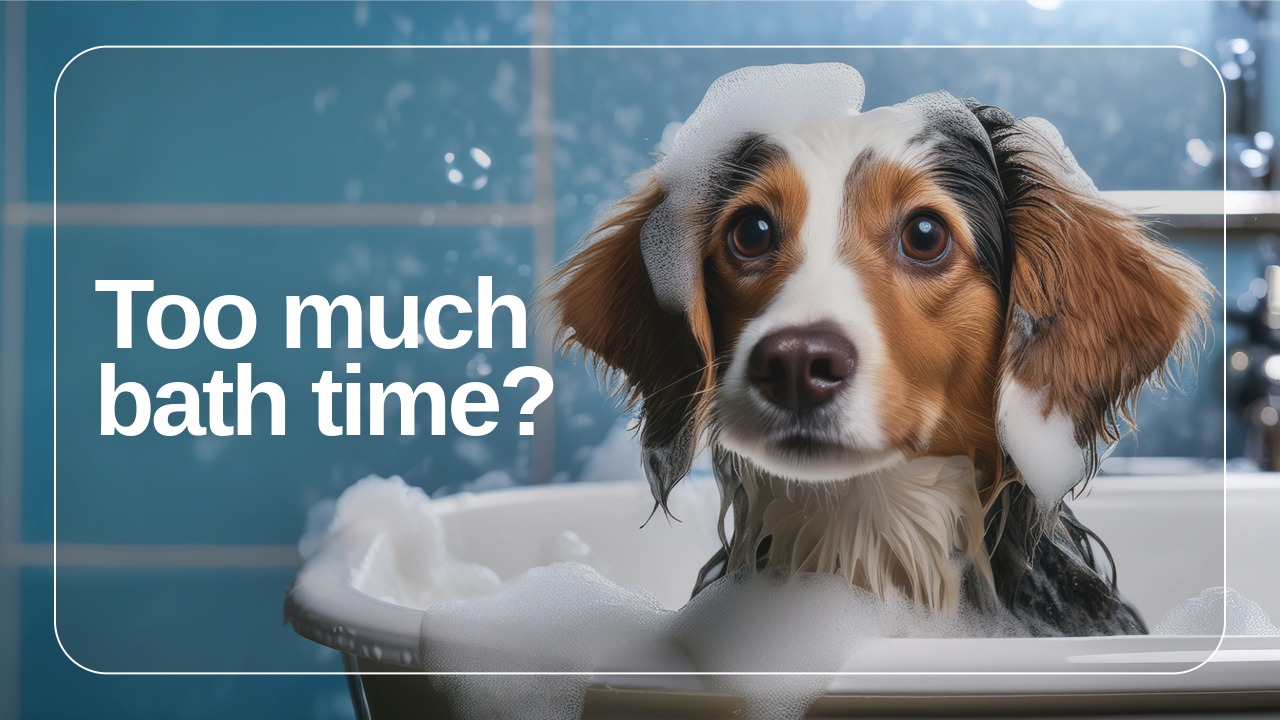published on: 24.06.2025

Are you bathing your pet too much? Why Less Is More for a Healthy Coat
Giving your pet a bath often feels like an act of love and care. But while your intentions are good, frequent bathing can sometimes do more harm than good. Soaps and even warm water can strip away the natural oils and beneficial bacteria that protect your animal's skin and keep their coat healthy. Understanding the right balance is key to keeping your furry friend clean, comfortable, and healthy without causing unintended irritation.
Key Takeaways
- Over-bathing strips natural oils, leading to dry, itchy skin and a dull coat.
- Most dogs only need a bath every 4-6 weeks, depending on their breed, lifestyle, and health.
- Cats are excellent self-groomers and rarely require a bath unless they are dirty with something they can't clean themselves or have a medical need.
- Look for signs of over-bathing like flaking, redness, or constant scratching.
- Alternatives like regular brushing, pet wipes, and dry shampoo are great for keeping pets clean between full baths.
Why Too Many Baths Can Hurt Your Pet's Skin
A pet's skin has a delicate balance of natural oils and microscopic organisms that work together to form a protective barrier. These oils are essential because they keep the coat shiny, prevent dryness, and help defend against harmful germs. When you bathe your pet too often, you repeatedly wash away these protective oils. This can leave their skin vulnerable, dry, flaky, and itchy. An itchy dog is more likely to scratch excessively, which can break the skin and lead to painful 'hot spots' (patches of inflamed, infected skin) or other secondary infections. A recent study confirmed that frequent bathing can alter the normal skin bacteria (also called microbiota) on a dog, potentially leading to irritation (National Library of Medicine).
How Often Should You Bathe a Dog?
There isn't a single, one-size-fits-all bathing schedule for dogs. The right frequency depends entirely on your specific dog's coat type, activity level, and overall health. For example, a long-haired Golden Retriever who loves swimming in the lake will need baths more often than a short-haired Chihuahua who spends most of its time indoors.
As a general guideline, the American Kennel Club suggests that many healthy dogs do well with a bath every four to six weeks. If you're unsure, it's always best to observe your dog's skin and coat. When they start to look or smell dirty, it's probably time for a wash. Don't just bathe them based on a rigid calendar.
What About Bathing Cats?
Most cats rarely, if ever, need a bath. They are meticulous groomers, spending a significant portion of their day—up to half of their waking hours—keeping themselves clean. Their tongues are specially designed with tiny, backward-facing spines called papillae that act like a built-in comb to remove dirt and loose fur.
According to the ASPCA, you should only bathe a cat when it's absolutely necessary. This might be because they've gotten into something sticky, oily, or toxic that they can't clean off themselves, or if a veterinarian has prescribed a medicated shampoo for a skin condition. If a bath is needed, a good rule of thumb is no more than once every four to six weeks.
Signs You Might Be Over-Bathing Your Pet
Your pet's body will often give you clear signs if their bath schedule is too frequent. Paying attention to these signals can help you adjust their routine before minor irritation becomes a bigger problem.
- Dry or Flaky Skin: You might see white flakes, similar to dandruff, in their fur or on their bedding.
- Dull, Brittle Coat: The fur may lose its natural shine and feel coarse or dry to the touch.
- Frequent Scratching or Licking: Your pet may seem constantly itchy, trying to soothe their irritated skin.
- Redness or Sores: In more serious cases, you might see inflamed patches of skin or small sores from excessive scratching.
Catching these signs early can save your pet from discomfort and save you from potentially costly veterinary bills for skin treatments.
Gentle and Effective Cleaning Alternatives
Keeping your pet clean doesn't always require a full-body bath with soap and water. Several gentler alternatives can help you maintain their hygiene and freshen them up without stripping their skin's natural oils. These methods are perfect for spot-cleaning after a muddy walk or just for regular upkeep between baths.
| Cleaning Method | Pros | Cons |
|---|---|---|
| Full Bath | Deepest clean, removes heavy dirt/allergens | Can strip natural oils, stressful for some pets |
| Brushing | Distributes oils, removes loose fur, bonding | Doesn't remove stubborn dirt or smells |
| Pet Wipes | Quick, convenient for spot-cleaning | Not effective for full-body cleaning, can be costly |
| Dry Shampoo | Freshens coat, no water needed | Can leave a residue, doesn't actually remove dirt |
- Regular Brushing: This is the single best thing you can do for your pet's coat. It removes loose hair, dander, and dirt while distributing their natural oils evenly.
- Pet Wipes or a Damp Cloth: These are great for cleaning muddy paws, dirty faces, or messy rears without needing a full soak.
- Dry or Waterless Shampoo: Pet-specific dry shampoos can absorb excess oil and freshen your pet's smell, making them a great in-between bath solution.
- A Healthy Diet: A balanced diet rich in omega fatty acids provides the building blocks for healthy skin and a shiny coat from the inside out.
FAQ: Pet Bathing Basics
Q: What kind of shampoo should I use for my pet?
A: Always use a shampoo specifically formulated for your pet's species (dog or cat). Human shampoos have a different pH level and can be harsh on their skin. Look for gentle, soap-free, or oatmeal-based formulas if your pet has sensitive skin.
Q: How can I make bath time less stressful for my pet?
A: You can make baths a much more positive experience with a little preparation. Try these steps:
Q: My dog rolled in something stinky. Do I have to give a full bath?
A: Not always! If the mess is localized, you can often spot-clean the area with a pet wipe or a damp cloth and some pet shampoo. If a full bath is unavoidable, focus the shampoo on the affected area and rinse thoroughly.
References
- American Kennel Club, “How Often Should You Wash Your Dog?”
- Ethos Veterinary Health, “How Often Should You Bathe Your Dog?”
- National Library of Medicine, “Impacts to canine dermal microbiota associated with repeated bathing”
- ASPCA, “Cat Grooming Tips”
- PetMD, “How to Bathe a Cat”
Come over for a visit at 77 Sulkhan Tsintsadze St, Tbilisi
Or call Us +995 599 996 487
